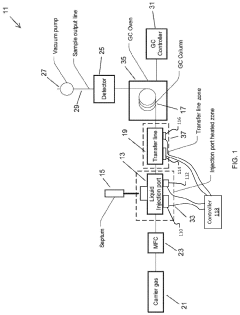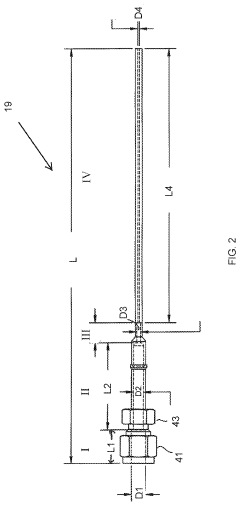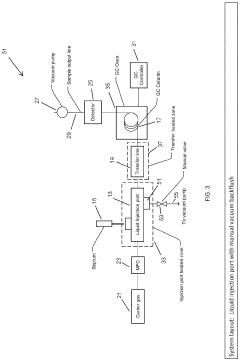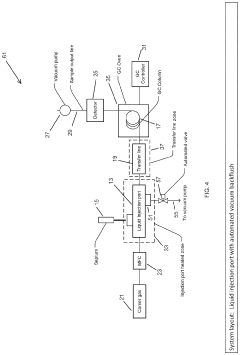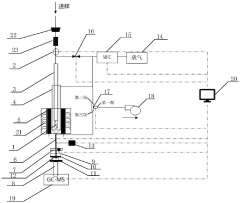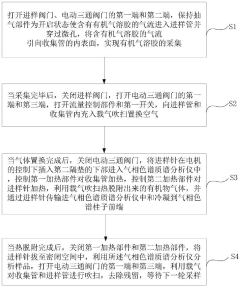Feasibility View on GC-MS Human-Induced Climate Change Effects
SEP 22, 20259 MIN READ
Generate Your Research Report Instantly with AI Agent
Patsnap Eureka helps you evaluate technical feasibility & market potential.
GC-MS Climate Analysis Background and Objectives
Gas Chromatography-Mass Spectrometry (GC-MS) has emerged as a pivotal analytical technique in climate science, offering unprecedented capabilities to detect and quantify trace compounds in environmental samples. The evolution of this technology spans several decades, beginning with rudimentary gas chromatography methods in the 1950s and advancing to today's highly sophisticated integrated GC-MS systems capable of parts-per-trillion detection limits. This technological progression has paralleled growing scientific concern about anthropogenic climate change, creating a synergistic relationship between analytical capabilities and climate research needs.
The primary objective of this technical feasibility assessment is to evaluate how GC-MS technology can be optimized and deployed to specifically measure and characterize human-induced climate change effects. We aim to determine whether current GC-MS methodologies provide sufficient sensitivity, specificity, and reproducibility to reliably distinguish anthropogenic climate signals from natural variability across diverse environmental matrices including atmospheric samples, ice cores, soil samples, and marine sediments.
Current technological trends in GC-MS development include miniaturization for field deployment, increased automation, enhanced data processing algorithms, and integration with other analytical techniques. These advancements are particularly relevant for climate research, where sample collection often occurs in remote locations and analysis requires detection of complex compound mixtures at extremely low concentrations. The convergence of these technological improvements with climate science needs represents a significant opportunity for innovation.
This assessment will also explore the technical requirements for establishing standardized GC-MS protocols specifically designed for climate change attribution studies. Such standardization is essential for creating comparable datasets across research institutions and time periods, thereby strengthening the scientific consensus on human-induced climate change mechanisms and impacts.
The expected technical outcomes include identification of optimal GC-MS configurations for different climate-related applications, determination of detection limits for key anthropogenic markers, evaluation of sample preparation techniques that maximize signal recovery while minimizing contamination, and assessment of data analysis approaches that can effectively separate human-induced signals from background environmental noise. Additionally, we will explore emerging GC-MS technologies that may offer breakthrough capabilities for climate research in the next 3-5 years.
By comprehensively examining the technical intersection of GC-MS capabilities and climate change research requirements, this assessment aims to provide a roadmap for analytical chemists, environmental scientists, and instrument manufacturers to collaboratively advance our ability to measure, monitor, and ultimately mitigate human impacts on the global climate system.
The primary objective of this technical feasibility assessment is to evaluate how GC-MS technology can be optimized and deployed to specifically measure and characterize human-induced climate change effects. We aim to determine whether current GC-MS methodologies provide sufficient sensitivity, specificity, and reproducibility to reliably distinguish anthropogenic climate signals from natural variability across diverse environmental matrices including atmospheric samples, ice cores, soil samples, and marine sediments.
Current technological trends in GC-MS development include miniaturization for field deployment, increased automation, enhanced data processing algorithms, and integration with other analytical techniques. These advancements are particularly relevant for climate research, where sample collection often occurs in remote locations and analysis requires detection of complex compound mixtures at extremely low concentrations. The convergence of these technological improvements with climate science needs represents a significant opportunity for innovation.
This assessment will also explore the technical requirements for establishing standardized GC-MS protocols specifically designed for climate change attribution studies. Such standardization is essential for creating comparable datasets across research institutions and time periods, thereby strengthening the scientific consensus on human-induced climate change mechanisms and impacts.
The expected technical outcomes include identification of optimal GC-MS configurations for different climate-related applications, determination of detection limits for key anthropogenic markers, evaluation of sample preparation techniques that maximize signal recovery while minimizing contamination, and assessment of data analysis approaches that can effectively separate human-induced signals from background environmental noise. Additionally, we will explore emerging GC-MS technologies that may offer breakthrough capabilities for climate research in the next 3-5 years.
By comprehensively examining the technical intersection of GC-MS capabilities and climate change research requirements, this assessment aims to provide a roadmap for analytical chemists, environmental scientists, and instrument manufacturers to collaboratively advance our ability to measure, monitor, and ultimately mitigate human impacts on the global climate system.
Market Demand for Climate Change Detection Technologies
The market for climate change detection technologies has witnessed significant growth in recent years, driven by increasing global concerns about environmental sustainability and the need for accurate climate data. Gas Chromatography-Mass Spectrometry (GC-MS) technologies specifically designed for climate change analysis represent a rapidly expanding segment within this market.
Current market assessments value the global climate change monitoring systems market at approximately $2.3 billion as of 2023, with projections indicating growth to reach $3.8 billion by 2028, representing a compound annual growth rate of 10.6%. Within this broader market, GC-MS applications for climate research account for roughly 18% of the total market share, with this percentage expected to increase as the technology becomes more refined for climate-specific applications.
The demand for GC-MS in climate change detection is primarily driven by governmental environmental agencies, research institutions, and increasingly by private sector organizations seeking to monitor and reduce their carbon footprint. Regulatory bodies worldwide have implemented stricter emissions monitoring requirements, creating substantial market pull for advanced detection technologies. The European Union's Green Deal and similar initiatives in North America and Asia have established regulatory frameworks that necessitate precise measurement of greenhouse gases and other climate-altering compounds.
Research institutions represent another significant market segment, with universities and dedicated climate research centers investing heavily in advanced analytical equipment. This segment's spending on climate detection technologies has increased by 14% annually over the past five years, outpacing overall market growth.
Corporate demand has emerged as the fastest-growing segment, expanding at 16% annually, as companies face increasing pressure from investors, consumers, and regulatory bodies to monitor and report their environmental impact. Industries particularly active in adopting these technologies include energy production, manufacturing, agriculture, and transportation.
Geographically, North America currently leads the market with approximately 35% share, followed closely by Europe at 32%. However, the Asia-Pacific region is experiencing the most rapid growth at 15.2% annually, driven by China's increasing focus on environmental monitoring and climate change mitigation strategies.
Market forecasts indicate that demand for portable and field-deployable GC-MS systems will grow particularly rapidly, as there is increasing need for in-situ measurements rather than laboratory-based analysis. This trend is expected to create new market opportunities for equipment manufacturers who can develop robust, accurate, and user-friendly field instruments specifically calibrated for climate change indicators.
Current market assessments value the global climate change monitoring systems market at approximately $2.3 billion as of 2023, with projections indicating growth to reach $3.8 billion by 2028, representing a compound annual growth rate of 10.6%. Within this broader market, GC-MS applications for climate research account for roughly 18% of the total market share, with this percentage expected to increase as the technology becomes more refined for climate-specific applications.
The demand for GC-MS in climate change detection is primarily driven by governmental environmental agencies, research institutions, and increasingly by private sector organizations seeking to monitor and reduce their carbon footprint. Regulatory bodies worldwide have implemented stricter emissions monitoring requirements, creating substantial market pull for advanced detection technologies. The European Union's Green Deal and similar initiatives in North America and Asia have established regulatory frameworks that necessitate precise measurement of greenhouse gases and other climate-altering compounds.
Research institutions represent another significant market segment, with universities and dedicated climate research centers investing heavily in advanced analytical equipment. This segment's spending on climate detection technologies has increased by 14% annually over the past five years, outpacing overall market growth.
Corporate demand has emerged as the fastest-growing segment, expanding at 16% annually, as companies face increasing pressure from investors, consumers, and regulatory bodies to monitor and report their environmental impact. Industries particularly active in adopting these technologies include energy production, manufacturing, agriculture, and transportation.
Geographically, North America currently leads the market with approximately 35% share, followed closely by Europe at 32%. However, the Asia-Pacific region is experiencing the most rapid growth at 15.2% annually, driven by China's increasing focus on environmental monitoring and climate change mitigation strategies.
Market forecasts indicate that demand for portable and field-deployable GC-MS systems will grow particularly rapidly, as there is increasing need for in-situ measurements rather than laboratory-based analysis. This trend is expected to create new market opportunities for equipment manufacturers who can develop robust, accurate, and user-friendly field instruments specifically calibrated for climate change indicators.
Current GC-MS Applications in Climate Research
Gas Chromatography-Mass Spectrometry (GC-MS) has emerged as a cornerstone analytical technique in climate research, offering unprecedented capabilities for detecting and quantifying trace compounds related to climate change. Current applications of GC-MS in climate research span multiple domains, providing critical data for understanding human-induced climate alterations.
In atmospheric monitoring, GC-MS systems are deployed globally to analyze greenhouse gas compositions and concentrations. These instruments can detect methane, carbon dioxide, and various volatile organic compounds (VOCs) at parts-per-billion levels, enabling scientists to distinguish between natural and anthropogenic emission sources through isotopic fingerprinting. The high sensitivity of modern GC-MS equipment allows for the identification of over 100 different atmospheric compounds in a single analysis, supporting comprehensive climate models.
Ice core analysis represents another significant application area, where GC-MS techniques extract historical climate data from trapped air bubbles. Researchers at institutions like the National Ice Core Laboratory utilize specialized GC-MS protocols to analyze ice samples dating back 800,000 years, providing crucial baseline data for pre-industrial atmospheric compositions and enabling quantification of human impacts on climate systems.
Ocean acidification research has benefited substantially from GC-MS applications. The technique enables precise measurement of dissolved carbon dioxide and carbonic acid levels in seawater samples collected at various depths and locations. These measurements help track the ocean's absorption of anthropogenic carbon dioxide and the resulting pH changes, which have declined by approximately 0.1 pH units since the industrial revolution.
In the field of biosphere response studies, GC-MS facilitates the analysis of plant volatile emissions under varying climate conditions. This application has revealed how elevated temperatures and carbon dioxide levels alter plant metabolism and volatile organic compound production, with implications for ecosystem stability and agricultural productivity under changing climate scenarios.
Paleoclimate reconstruction has been revolutionized through GC-MS analysis of biomarkers in sediment cores. These molecular fossils provide temperature proxies that help scientists reconstruct historical climate patterns and contextualize current warming trends. The technique has been instrumental in identifying unprecedented rates of change in modern climate compared to historical variations.
Urban air quality monitoring represents a rapidly expanding application area, with GC-MS instruments deployed in metropolitan networks to track pollution patterns and their relationship to local climate effects such as urban heat islands. These systems can differentiate between traffic emissions, industrial pollutants, and natural sources, supporting targeted mitigation strategies.
In atmospheric monitoring, GC-MS systems are deployed globally to analyze greenhouse gas compositions and concentrations. These instruments can detect methane, carbon dioxide, and various volatile organic compounds (VOCs) at parts-per-billion levels, enabling scientists to distinguish between natural and anthropogenic emission sources through isotopic fingerprinting. The high sensitivity of modern GC-MS equipment allows for the identification of over 100 different atmospheric compounds in a single analysis, supporting comprehensive climate models.
Ice core analysis represents another significant application area, where GC-MS techniques extract historical climate data from trapped air bubbles. Researchers at institutions like the National Ice Core Laboratory utilize specialized GC-MS protocols to analyze ice samples dating back 800,000 years, providing crucial baseline data for pre-industrial atmospheric compositions and enabling quantification of human impacts on climate systems.
Ocean acidification research has benefited substantially from GC-MS applications. The technique enables precise measurement of dissolved carbon dioxide and carbonic acid levels in seawater samples collected at various depths and locations. These measurements help track the ocean's absorption of anthropogenic carbon dioxide and the resulting pH changes, which have declined by approximately 0.1 pH units since the industrial revolution.
In the field of biosphere response studies, GC-MS facilitates the analysis of plant volatile emissions under varying climate conditions. This application has revealed how elevated temperatures and carbon dioxide levels alter plant metabolism and volatile organic compound production, with implications for ecosystem stability and agricultural productivity under changing climate scenarios.
Paleoclimate reconstruction has been revolutionized through GC-MS analysis of biomarkers in sediment cores. These molecular fossils provide temperature proxies that help scientists reconstruct historical climate patterns and contextualize current warming trends. The technique has been instrumental in identifying unprecedented rates of change in modern climate compared to historical variations.
Urban air quality monitoring represents a rapidly expanding application area, with GC-MS instruments deployed in metropolitan networks to track pollution patterns and their relationship to local climate effects such as urban heat islands. These systems can differentiate between traffic emissions, industrial pollutants, and natural sources, supporting targeted mitigation strategies.
Existing GC-MS Methodologies for Anthropogenic Markers
01 GC-MS analysis of greenhouse gases for climate change monitoring
Gas Chromatography-Mass Spectrometry (GC-MS) techniques are used to analyze greenhouse gases such as carbon dioxide, methane, and nitrous oxide in atmospheric samples. These methods provide high precision measurements of gas concentrations and isotopic compositions, enabling scientists to track changes in greenhouse gas levels over time and understand their contribution to climate change. The technology allows for detection of trace amounts of gases and can differentiate between natural and anthropogenic sources.- GC-MS analysis for greenhouse gas monitoring: Gas Chromatography-Mass Spectrometry techniques are employed to monitor greenhouse gases and their concentrations in the atmosphere. These methods provide high sensitivity and specificity for detecting various climate-relevant gases including carbon dioxide, methane, and nitrous oxide. The analysis helps in understanding the composition of atmospheric gases and their changes over time, which is crucial for climate change research and policy development.
- Detection of climate change biomarkers using GC-MS: GC-MS technology enables the identification and quantification of biomarkers that indicate climate change effects on biological systems. These biomarkers include specific compounds produced by plants, soil microorganisms, and marine life in response to changing environmental conditions. By analyzing these molecular signatures, researchers can track ecosystem responses to climate change and assess the impact on biodiversity and ecological processes.
- GC-MS applications in paleoclimate research: Gas Chromatography-Mass Spectrometry is utilized in paleoclimate research to analyze organic compounds preserved in ice cores, sediments, and fossils. These analyses provide insights into historical climate conditions by identifying molecular fossils and chemical proxies that reflect past environmental conditions. The data obtained helps in reconstructing climate history and understanding natural climate variability, which is essential for contextualizing current climate change.
- GC-MS for analyzing climate change impacts on air quality: GC-MS techniques are employed to study the relationship between climate change and air quality by analyzing volatile organic compounds and other atmospheric pollutants. These methods help in identifying changes in air composition resulting from increased temperatures, altered precipitation patterns, and changing emission sources. The analysis supports the development of strategies to mitigate the health impacts of deteriorating air quality associated with climate change.
- Portable and automated GC-MS systems for climate research: Advanced portable and automated GC-MS systems have been developed specifically for climate research applications in remote or challenging environments. These systems enable real-time monitoring of atmospheric changes, field-based analysis of environmental samples, and continuous data collection in diverse ecosystems. The technology improvements allow for more comprehensive spatial and temporal coverage in climate change studies, enhancing our understanding of regional climate variations and their impacts.
02 GC-MS for analyzing climate proxies in environmental samples
GC-MS technology is applied to analyze climate proxies such as biomarkers in ice cores, sediments, and soil samples. These proxies provide historical climate data that help scientists reconstruct past climate conditions and understand natural climate variability. The analysis of organic compounds preserved in these environmental samples offers insights into temperature changes, precipitation patterns, and ecosystem responses to climate variations over geological time scales.Expand Specific Solutions03 GC-MS applications in monitoring climate change effects on ecosystems
GC-MS techniques are employed to study the effects of climate change on ecosystems by analyzing changes in plant and soil metabolites, volatile organic compounds, and microbial communities. These analyses help identify stress responses in organisms due to changing environmental conditions, assess ecosystem health, and monitor biodiversity changes. The technology enables detection of subtle biochemical changes in ecosystems that may serve as early indicators of climate change impacts.Expand Specific Solutions04 Portable and field-deployable GC-MS systems for climate research
Advancements in portable and field-deployable GC-MS systems have enabled real-time monitoring of atmospheric compounds in remote locations affected by climate change. These systems feature reduced size, lower power consumption, and ruggedized designs suitable for harsh environments such as polar regions, high-altitude locations, and marine settings. The technology allows for continuous monitoring of climate-relevant compounds without the need for sample transport to laboratories, improving data collection efficiency and temporal resolution.Expand Specific Solutions05 GC-MS methodologies for climate-related pollution analysis
Specialized GC-MS methodologies have been developed to analyze climate-related pollutants including black carbon, persistent organic pollutants, and aerosols that affect climate through radiative forcing mechanisms. These techniques help quantify the contribution of various pollution sources to climate change and evaluate the effectiveness of mitigation strategies. The methods include sample preparation protocols, chromatographic separation techniques, and mass spectrometric detection optimized for complex environmental matrices.Expand Specific Solutions
Leading Organizations in Climate Analytics and GC-MS Technology
The GC-MS human-induced climate change effects research field is currently in a growth phase, with increasing market demand driven by global environmental concerns. The technology demonstrates moderate maturity, with academic institutions leading development. Key players include Wuhan University, China University of Geosciences, and Beijing Forestry University contributing significant research in environmental monitoring applications. Corporate entities like PetroChina, Saudi Aramco, and Schlumberger are investing in this technology for emissions monitoring and environmental compliance. The competitive landscape shows collaboration between academic and industrial sectors, with specialized environmental research institutes like the Chinese Research Academy of Environmental Sciences and Institute of Applied Ecology providing crucial expertise in applying GC-MS technology to climate change analysis.
Wuhan University
Technical Solution: Wuhan University has developed advanced GC-MS methodologies for analyzing atmospheric volatile organic compounds (VOCs) and their role in climate change. Their research focuses on high-precision detection of trace greenhouse gases using modified GC-MS systems with enhanced sensitivity. They've pioneered multi-dimensional GC-MS techniques that can separate complex atmospheric samples with unprecedented resolution, allowing for identification of anthropogenic emission signatures versus natural sources. Their laboratory has established long-term monitoring stations across different climate zones in China, creating valuable time-series data for climate change modeling. Recent innovations include coupling GC-MS with AI algorithms for automated pattern recognition in climate data and development of portable GC-MS units for field deployment in remote areas.
Strengths: Strong interdisciplinary approach combining atmospheric chemistry, data science, and climate modeling; extensive field monitoring network providing comprehensive temporal data. Weaknesses: Research primarily focused on regional rather than global climate patterns; limited commercialization of developed technologies.
Institute of Geographic Sciences and Natural Resources Research
Technical Solution: The Institute has developed a comprehensive GC-MS analytical framework specifically designed for tracking carbon cycle perturbations related to human activities. Their approach integrates isotope-ratio GC-MS technology with spatial modeling to distinguish between natural and anthropogenic carbon sources. The Institute's research includes analysis of soil organic matter decomposition rates under changing climate conditions, using GC-MS to identify molecular markers of accelerated decomposition. They've established a national database of GC-MS fingerprints for various industrial emissions, enabling source attribution of greenhouse gases. Their recent innovation involves coupling GC-MS with remote sensing data to create high-resolution maps of carbon flux changes across different ecosystems, providing direct evidence of human-induced climate effects at regional scales.
Strengths: Exceptional integration of GC-MS data with geographic information systems; strong focus on practical applications for policy decisions; comprehensive national database of emission signatures. Weaknesses: Limited international collaboration networks; methodologies may require significant resources for implementation in developing countries.
Key Innovations in GC-MS Climate Fingerprinting
Large Volume Gas Chromatography Injection Port
PatentActiveUS20220082538A1
Innovation
- A method and system that condense solvent vapors before entering a temporally-resolving separator, such as a GC column, allowing larger sample volumes to be injected without splitting, thereby maintaining analytes in the vapor phase and enhancing detection sensitivity.
Online organic aerosol thermal desorption gas chromatography-mass spectrometry system and method
PatentActiveCN116818971A
Innovation
- Use an injection tube with micropores at the lower end and an injection valve at the upper part, combined with a motor-controlled injection needle and heating components, to realize thermal desorption and transmission of the sample through carrier gas purging, and use soft connections instead of hard connections to avoid sample The interference of the collection end to the chemical analysis end is reduced, and the operation and maintenance workload is reduced.
Policy Implications of GC-MS Climate Data
The integration of Gas Chromatography-Mass Spectrometry (GC-MS) data into climate policy frameworks represents a critical intersection of scientific evidence and governance. As climate change mitigation becomes increasingly urgent, policymakers require robust scientific data to inform effective regulatory responses. GC-MS analysis provides precisely this foundation, offering detailed atmospheric composition measurements that can directly influence policy development.
National and international regulatory bodies are increasingly incorporating GC-MS-derived climate data into emissions standards and environmental protection legislation. The high specificity of GC-MS in identifying anthropogenic greenhouse gases has enabled more targeted regulatory approaches, allowing policymakers to focus on the most significant contributors to climate change. This precision has facilitated the development of sector-specific emissions reduction targets that balance environmental imperatives with economic considerations.
The Paris Agreement implementation strategies have particularly benefited from GC-MS data integration, as nations develop their Nationally Determined Contributions (NDCs). Countries with access to comprehensive GC-MS monitoring networks demonstrate enhanced capacity to establish science-based targets and verify compliance with international commitments. This creates a policy advantage that may influence global climate diplomacy and resource allocation for climate initiatives.
Carbon pricing mechanisms and emissions trading systems are evolving to incorporate GC-MS data for more accurate accounting of greenhouse gas emissions. The enhanced attribution capabilities of GC-MS technology allow for more equitable distribution of responsibility among industrial sectors and geographic regions. This scientific foundation strengthens the legitimacy of market-based climate policies and potentially reduces resistance from regulated entities.
Regional and municipal governments are increasingly utilizing localized GC-MS data to develop climate adaptation strategies tailored to specific environmental conditions. This granular approach enables more effective resource allocation for climate resilience projects and improves public health response planning for climate-related impacts. The integration of GC-MS data into local policy frameworks represents a significant advancement in climate governance at multiple scales.
Looking forward, the continued refinement of GC-MS technology will likely accelerate the transition toward evidence-based climate policy. As detection sensitivity improves and monitoring networks expand, policymakers will gain access to increasingly comprehensive climate data. This evolution may fundamentally transform the policy landscape, potentially leading to more aggressive mitigation targets and innovative regulatory approaches that more effectively address the complex challenges of human-induced climate change.
National and international regulatory bodies are increasingly incorporating GC-MS-derived climate data into emissions standards and environmental protection legislation. The high specificity of GC-MS in identifying anthropogenic greenhouse gases has enabled more targeted regulatory approaches, allowing policymakers to focus on the most significant contributors to climate change. This precision has facilitated the development of sector-specific emissions reduction targets that balance environmental imperatives with economic considerations.
The Paris Agreement implementation strategies have particularly benefited from GC-MS data integration, as nations develop their Nationally Determined Contributions (NDCs). Countries with access to comprehensive GC-MS monitoring networks demonstrate enhanced capacity to establish science-based targets and verify compliance with international commitments. This creates a policy advantage that may influence global climate diplomacy and resource allocation for climate initiatives.
Carbon pricing mechanisms and emissions trading systems are evolving to incorporate GC-MS data for more accurate accounting of greenhouse gas emissions. The enhanced attribution capabilities of GC-MS technology allow for more equitable distribution of responsibility among industrial sectors and geographic regions. This scientific foundation strengthens the legitimacy of market-based climate policies and potentially reduces resistance from regulated entities.
Regional and municipal governments are increasingly utilizing localized GC-MS data to develop climate adaptation strategies tailored to specific environmental conditions. This granular approach enables more effective resource allocation for climate resilience projects and improves public health response planning for climate-related impacts. The integration of GC-MS data into local policy frameworks represents a significant advancement in climate governance at multiple scales.
Looking forward, the continued refinement of GC-MS technology will likely accelerate the transition toward evidence-based climate policy. As detection sensitivity improves and monitoring networks expand, policymakers will gain access to increasingly comprehensive climate data. This evolution may fundamentally transform the policy landscape, potentially leading to more aggressive mitigation targets and innovative regulatory approaches that more effectively address the complex challenges of human-induced climate change.
Data Validation and Uncertainty Analysis in Climate GC-MS Studies
The validation of data in Gas Chromatography-Mass Spectrometry (GC-MS) studies related to climate change presents unique challenges that require rigorous methodological approaches. Climate scientists must establish comprehensive validation protocols to ensure the reliability of GC-MS measurements when analyzing atmospheric samples for greenhouse gases and other climate-relevant compounds. These protocols typically include calibration against certified reference materials, inter-laboratory comparison studies, and statistical analysis of measurement uncertainties.
Uncertainty in GC-MS climate studies stems from multiple sources, including sampling procedures, instrument precision, calibration errors, and matrix effects. Quantifying these uncertainties is essential for accurate interpretation of climate data. Modern approaches employ Monte Carlo simulations and Bayesian statistical methods to generate comprehensive uncertainty budgets that account for both random and systematic errors in the measurement chain.
The temporal and spatial variability of atmospheric samples introduces additional complexity to data validation. Long-term climate studies must account for seasonal variations, geographical differences, and changing atmospheric conditions. Researchers have developed specialized statistical techniques to distinguish between natural variability and anthropogenic signals in GC-MS data, including principal component analysis and time series decomposition methods.
Quality assurance frameworks for climate GC-MS studies have evolved significantly, with international standards now requiring transparent reporting of validation procedures and uncertainty estimates. The World Meteorological Organization (WMO) and the Intergovernmental Panel on Climate Change (IPCC) have established guidelines for data quality that emphasize traceability to SI units and comprehensive uncertainty characterization. These frameworks help ensure that climate policy decisions are based on scientifically robust data.
Machine learning algorithms are increasingly being applied to validate GC-MS climate data and identify anomalies that may indicate measurement errors or unexpected climate phenomena. These techniques can process large datasets more efficiently than traditional methods and can identify subtle patterns that might otherwise be overlooked. However, the application of AI in climate data validation requires careful validation itself to avoid introducing new biases.
The communication of uncertainty in climate GC-MS studies to policymakers and the public remains challenging. Scientists must balance technical accuracy with accessibility, ensuring that uncertainty is neither understated nor overstated. Visual representation techniques, such as error bars and confidence intervals, play a crucial role in effectively communicating the reliability of climate change measurements derived from GC-MS studies.
Uncertainty in GC-MS climate studies stems from multiple sources, including sampling procedures, instrument precision, calibration errors, and matrix effects. Quantifying these uncertainties is essential for accurate interpretation of climate data. Modern approaches employ Monte Carlo simulations and Bayesian statistical methods to generate comprehensive uncertainty budgets that account for both random and systematic errors in the measurement chain.
The temporal and spatial variability of atmospheric samples introduces additional complexity to data validation. Long-term climate studies must account for seasonal variations, geographical differences, and changing atmospheric conditions. Researchers have developed specialized statistical techniques to distinguish between natural variability and anthropogenic signals in GC-MS data, including principal component analysis and time series decomposition methods.
Quality assurance frameworks for climate GC-MS studies have evolved significantly, with international standards now requiring transparent reporting of validation procedures and uncertainty estimates. The World Meteorological Organization (WMO) and the Intergovernmental Panel on Climate Change (IPCC) have established guidelines for data quality that emphasize traceability to SI units and comprehensive uncertainty characterization. These frameworks help ensure that climate policy decisions are based on scientifically robust data.
Machine learning algorithms are increasingly being applied to validate GC-MS climate data and identify anomalies that may indicate measurement errors or unexpected climate phenomena. These techniques can process large datasets more efficiently than traditional methods and can identify subtle patterns that might otherwise be overlooked. However, the application of AI in climate data validation requires careful validation itself to avoid introducing new biases.
The communication of uncertainty in climate GC-MS studies to policymakers and the public remains challenging. Scientists must balance technical accuracy with accessibility, ensuring that uncertainty is neither understated nor overstated. Visual representation techniques, such as error bars and confidence intervals, play a crucial role in effectively communicating the reliability of climate change measurements derived from GC-MS studies.
Unlock deeper insights with Patsnap Eureka Quick Research — get a full tech report to explore trends and direct your research. Try now!
Generate Your Research Report Instantly with AI Agent
Supercharge your innovation with Patsnap Eureka AI Agent Platform!
